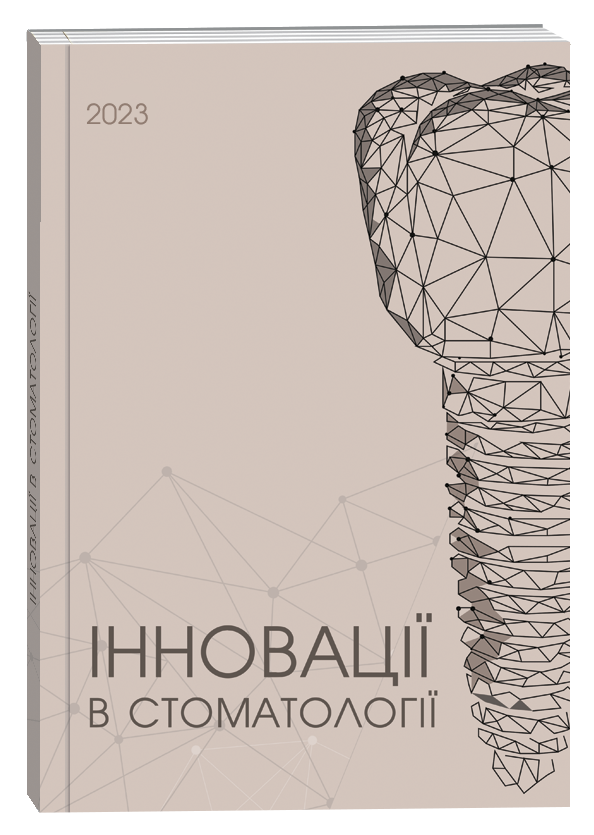DIRECT PROSTHETICS AS AN EFFECTIVE METHOD OF RESTORATION AFTER TOOTH EXTRACTION: PROSPECTS AND DISADVANTAGES
DOI:
https://doi.org/10.35220/2523-420X/2023.1.5Keywords:
direct prosthetics, dental implantation, implant prosthesis, dental defectAbstract
The purpose of this paper is to review and present current knowledge about direct prosthetics as an effective method of restoration after tooth extraction. Research methods. Content analysis of domestic and foreign scientific sources, bibliosemantic, analytical research methods were used. Scientific novelty. The results of the review of modern scientific literature indicate a significant prevalence of the use of direct prosthetics among patients after tooth extraction. A number of studies confirm the idea that the use of direct prosthetics along with surgical interventions shortens the treatment period. As a primary immediate prosthesis, a lamellar removable prosthesis with retaining or supporting clasps is used, as well as modern and rational methods of manufacturing a direct removable prosthesis (implant prosthesis). Direct prosthetics is often used to meet the aesthetic and functional requirements of patients. The development of new materials and 3D printing, which is used to create temporary and permanent dental crowns, for complex treatment and monitoring of patient rehabilitation, has made a huge contribution to dentistry. Modern achievements and trends emphasize the need for direct prosthetics in the complex treatment of periodontal diseases accompanied by tooth extraction with the scheme of application of orthopedic methods in this complex: direct prosthetics, temporary splinting and permanent prosthetics. Conclusions. Thus, direct prosthetics is a modern and widespread method that is widely used for implant rehabilitation of patients with dentition defects. It is important to improve the methods of manufacturing removable immediate dentures, as well as to search for an innovative base material for the effectiveness of treatment in orthopedic dentistry, which is directly aimed at the rehabilitation of patients with dentition defects.
References
Is the timing of implant placement and loading influencing esthetic outcomes in single-tooth implants? A systematic review / H. Francisco, D. Marques, C. Pinto, L. Aiquel, J. Caramês. Clin Oral Implants Res. 2021. Suppl 21. р. 28-55. doi: 10.1111/clr.13811.
Effect of connective tissue grafting on periimplant tissue in single immediate implant sites: A RCT / E.G. Zuiderveld, H.J.A. Meijer, L. den Hartog, A. Vissink, G.M. Raghoebar. J Clin Periodontol. 2018. Vol. 45(2). P. 253-264. doi: 10.1111/jcpe.12820.
Digital Workflow for Immediate Implant Placement and Chairside Provisionalization in the Esthetic Zone / V.J.J. Donker, G.M. Raghoebar, A. Vissink, H.J.A. Meijer. Case Rep Dent. 2022. Vol. 2022. p. 5114332. doi: 10.1155/2022/5114332.
Gamborena I., Sasaki Y., Blatz M.B. Predictable immediate implant placement and restoration in the esthetic zone. J Esthet Restor Dent. 2021. Vol. 33(1). p. 158-172. doi: 10.1111/jerd.12716.
Is the use of digital technologies for the fabrication of implant-supported reconstructions more efficient and/or more effective than conventional techniques: A systematic review/ S. Mühlemann, R.D. Kraus, C.H.F. Hämmerle, D.S. Thoma. Clin Oral Implants Res. 2018 Oct;29 Suppl 18:184-195. doi: 10.1111/clr.13300.
European Association for Osseointegration Delphi study on the trends in Implant Dentistry in Europe for the year 2030 / M. Sanz, B. Noguerol, I. Sanz-Sanchez, C.H.F. Hammerle, H. Schliephake, F. Renouard et al. Clin. Oral Implants Res. 2019. Vol. 30 (5). p. 476–86. doi: 10.1111/clr.13431.
Yeung S., Jivraj S. Rationale for Immediate Loading. In: Jivraj S. editor. Graftless Solutions for the Edentulous Patient. BDJ Clinician’s Guides. 2018. p. 159–87.
Леоненко П.В., Кокоєва Ю.В., Леоненко Г.П. Результати застосування вдосконаленого алгоритму безпосереднього протезування з опорою на дентальних імплантатах з персоналізованим підходом. Сучасна стоматологія. 2021. № 2. С. 56-66. doi: 10.33295/1992-576X-2021-2-56.
Implant placement and loading protocols in partially edentulous patients: A systematic review / G.O. Gallucci, A. Hamilton, W. Zhou, D. Buser, S. Chen. Clin. Oral Implants Res. 2018. Vol. 29 (Suppl. 16). p. 106–34. doi: 10.1111/clr.13276.4.
Immediate versus early or conventional loading dental implants with fixed prostheses: A systematic review and meta-analysis of randomized controlled clinical trials / J. Chen, M. Cai, J. Yang, T. Aldhohrah, Y. Wang. J. Prosthet. Dent. 2019. Vol. 122 (6). p. 516–36. doi: 10.1016/j.prosdent.2019.05.013.
Безпосереднє та проміжне протезування / Метод. реком. для студентів стомат. факультету / Укл. В.П. Голік, Г.Г. Грішанін, В.П. Лазуткін, М.В. Богатиренко. Харків: ХНМУ, 2014. 20 с.
Esquivel J., Meda R.G., Blatz M.B. The Impact of 3D Implant Position on Emergence Profile Design. Int J Periodontics Restorative Dent. 2021 Vol. 41(1). p. 79-86. doi: 10.11607/prd.5126.
Леоненко П.В., Кокоєва Ю.В. Експериментальне обґрунтування комбінації конструкційних матеріалів та персоналізованих протетичних елементів для протезування на дентальних імплантатах. Сучасна стоматологія. 2020. № 2. С. 76-83. doi: 10.33295/1992-576X-2020-2-76.
Особливості фіксації знімних пластинкових протезів / І.А. Ніколішин, Е.В. Ніколішина, В.М. Дворник та ін. Вісник проблем біології і медицини. 2020. Вип. 4 (158). С. 352‒356. doi: 10.29254/2077-4214-2020-4-158-352-356.
Математичне обґрунтування застосування іммедіат-протеза для протезування включених дефектів зубних рядів / В.М. Дворник, Р.В. Петренко, О.С. Шеметов. Український стоматологічний альманах. 2014. №. 2. С. 45-48.
Höhne C, Schmitter M. Control of occlusal rehabilitation with 3D-printed crowns. Int J Comput Dent. 2022. Vol. 25(3). p. 325-332. doi: 10.3290/j.ijcd.b3380909.








